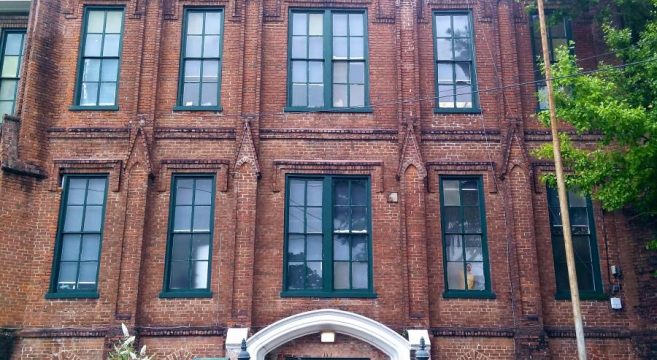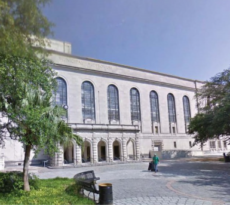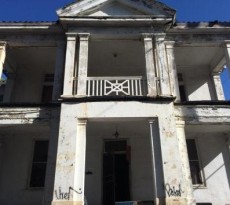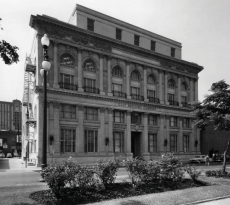Each year, the Louisiana Landmark Society releases its annual list of New Orleans’ most endangered historic sites. You can see prior years for 2018 (here), 2017 (here) and 2015 (here).
Last week, the Louisiana Landmarks Society released its 2019 list, which you can see below. All photos courtesy of the Louisiana Landmark Society.

1. General Laundry
LOCATION: Tremé
THREAT: Demolition by Neglect
2532-36 St. Peter Street – Decades of negligence are willfully destroying “the most outstanding Art Deco building in New Orleans.” When the dazzling 1927 General Laundry was placed on the National Register of Historic Places in 1974, the report stated, “it epitomizes [Art Deco], as does no other…building in New Orleans…” in 2014, the current owner requested demolition, but was denied by a deed restriction requiring Sate Historic Preservation Office approval. Today, water damaged and partially roofless, this landmark is allowed to deteriorate daily in plain sight of code enforcement; yet its brilliance shines to inspire anyone with eyes and heart.

2. Three-Bay Creole Cottage
LOCATION: Tremé
THREAT: Demolition by Neglect
1016 N. Roman Street – The New Orleans three-bay Creole cottage is a fairly rare vernacular type. It came into fashion about 1845, and was generally out by 1850. With its elongated rear slope accommodating a three-room deep plan, the three-bay Creole cottage represents an important evolutionary link between the floor plan and massing of the Creole cottage and that of the shotgun house. The example on North Roman was built by free man of color Lenoville Pascal, a local builder who began to assemble the land in 1849. Since 1968 the house has been in the hands of a local family and has passed into an estate with multiple owners. Today, the house sits deteriorating.

3. McDonogh No.7 School
LOCATION: Uptown
THREAT: Demolition by Neglect
1111 Milan Street – Designed by renowned architect William A. Freret, this stately brick edifice is one of the oldest remaining McDonogh Schools in New Orleans. The building, which currently houses Audubon Charter School, has endured years of deferred maintenance. Citing the cost of renovation, the Orleans Parish School Board recently classified it as surplus property. The Board is currently reported to be negotiating a property swap with the Housing Authority of New Orleans with no concrete plans for the school’s continued use or redevelopment. Reported Housing Authority plans to demolish the building in favor of dense apartments are a real threat.

4. Circle Food Store
LOCATION: 7th Ward
THREAT: Repetitive Flooding
1532 St. Bernard Avenue – The iconic 1931 Circle Food Store, a beloved, black-owned community hub that offered fresh food, goods and services to the Tremé and 7th Ward neighborhoods faces peril because of repetitive flooding and development pressure. Designed by architect, Sam Stone, Jr., the store was named for the St. Bernard Avenue traffic circle destroyed by the construction of Interstate 10. The grocery, acquired from the city in 1938 by an African-American vendor, replaced the St. Bernard Market, one of 36 markets. Following Hurricane Katrina, the building underwent an $8 million renovation. It reopened in 2014 but was inundated again by the infamous August 5, 2017 flood and another 8 months later. Financial woes forced an auction of the Mission Revival building in 2019, and now tensions rise as the neighborhood waits to see if the new owner will redevelop the store in a way that serves the nearby community.

5. Belgian Paving Stones
LOCATION: Lafayette Square Historic District
THREAT: Deterioration and Disrepair due to Neglect
600-800 Blocks of St. Joseph Street – With a rough, durable surface that became disfavored with the emergence of automobiles, the mid-nineteenth century paving stones covering city streets were mostly paved over with asphalt in the early twentieth century. Called Belgian blocks, the stones remained in place and served as foundational support for the new street surface. On only a handful of streets did the stones remain exposed, lending an undeniable charm and authenticity to the historic streetscape. St. Joseph Street from Baronne to Camp was among those few streets that managed to retain its exposed paving stone surface. Today the paving stones are threatened by chronic neglect and years of construction projects along St Joseph Street.

6. Sewerage & Water Infrastructure
LOCATION: Citywide
THREAT: Deteriorated Infrastructure, Pumping and Power Systems-along with lack of funding and political prioritization
New Orleans – With the innovation of the Albert Baldwin Wood’s Screw Pumps and drainage system, New Orleans was a world leader in urban water management–reducing disease conditions, making land available for modest homes and allowing the city’s economy to grow. Recent decades of neglect and political maneuvering, coupled with a lack of investment and prioritization of the infrastructure, have led to precarious storm and drinking water systems. Repeated episodes of flooding and boil-water advisories threaten our historic structures, resources, culture and tourism dollars. We are at a critical juncture that requires heavy investment in our infrastructure.

7. 425 Celeste Street
LOCATION: Lower Garden District
THREAT: Demolition by Neglect/Full Demolition
425 Celeste Street – This three-story Greek revival style store-house stands as a lonely reminder of the importance of the riverfront area of the Lower Garden District in the economic development of 19th Century New Orleans. Today this significant circa 1865 commercial remnant faces several threats, the most immediate of which is demolition by neglect. Architectural details such as cast-iron columns are weathering and falling off, and several column capitals are missing. While cited as a contributing element to the National Register’s Lower Garden District, it does not fall within the Historic Districts Landmark Commission’s jurisdiction local protection. A second threat to this building is that it will be consumed by the large-scale development planned in the immediate area.

8. Creole Cottage
LOCATION: Holy Cross
THREAT: Demolition by Neglect and Blight Removal
5763 Dauphine Street – City Agencies have three times cited owners of this circa 1880 Creole cottage in the Holy Cross Historic District for blight. Built in the rear of the former Charbonnet Plantation, the cottage was once part of a farming area. Owned by a single family for most of its existence, the cottage has little by little lost its family as generations died or moved away. The issue of joint or missing owners is a constant threat to houses of this type. Recent city liens have increased the likelihood of demolition.

9. Neighborhood Theaters
LOCATION: Citywide
THREAT: Demolition by Neglect and Deliberate Demolition; Failure to Repurpose
New Orleans – Like the corner grocery the neighborhood theater was once a familiar and welcoming sight throughout the city. Built before the development of television and the widespread use of the automobile, they were accessible on foot and by bicycle. These theaters were places where friends and families could meet and enjoy the latest Hollywood movies. Over time, changes in technology that allowed movie viewing at home or at multiplex theaters in area shopping malls, along with the migration of people from city to suburbs resulted in much reduced attendance. Consequently, most theaters were closed and the buildings sold, with some demolished or left to decay, leading to the disappearance of a much-loved institution.
Established in 1950, Louisiana Landmarks Society is one of the state’s oldest nonprofit preservation organizations, whose mission is to promote historic preservation through education, advocacy and operation of the Pitot House. Louisiana Landmarks Society rapidly defined preservation advocacy in New Orleans through campaigns that resulted in the protection of Gallier Hall, the Carrollton Courthouse building, and defeat of the proposed Riverfront Expressway in the 1960s. Landmarks’ most visible manifestation of its preservation principles is the historic c. 1799 Pitot House. Landmarks Society removed the Pitot House from the threat of demolition in 1964 when it acquired and relocated the structure 200 feet to its present home. Today, the Pitot House functions as Landmarks’ headquarters and as a historic house museum and meeting place.




















